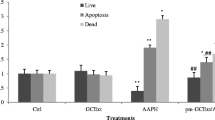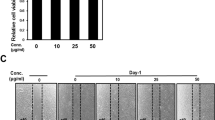Abstract
Although increasing evidence shows the nutritional benefits of calcium fructoborate (CF) on animals and humans, its action mechanism has not been clearly identified. The present study aims to investigate the possible antioxidant function of CF. Based on its efficiency in skin wound healing, the authors tested whether CF possesses antioxidant properties on human keratinocytes cultures, in a complete serum-free medium (KMK-2; Sigma). The cells treated with CF (0–450 nmol/culture medium) were exposed to exogenous 100 μmol of hydrogen peroxide to mimic the oxidative stress. The changes in general cell oxidant production evaluated with dihydrorhodamine-123 showed that the intracellular reactive oxygen species (ROS) were markedly reduced by preincubation with CF. The maximum antioxidant activity was notice at 90 nmol CF. To assess the reactivity of CF on ROS, we analyzed its ability to inhibit the superoxide-dependent auto-oxidation of pyrogallol. The CF inhibited the pyrogallol auto-oxidation depending on time and concentration, which suggests its possible role as a superoxide radical scavenger. Taken together, our results indicate that CF has antioxidant activity, which could have clinical significance in protecting cells from oxidant-induced injury. A hypothetic mechanism for the antioxidant activity of CF is proposed.
Similar content being viewed by others
References
F. H. Nielsen, Evidence for the nutritional essentiality of boron, J. Trace Elements Exp. Med. 9, 215–229 (1996).
W. G. Woods, An introduction to boron: history, sources, uses and chemistry, Environ. Health Perspect. 102(7), 5–11 (1994).
D. G. Blevins and K. M. Lukaszewski, Boron in plant structure and function, Annu. Rev. Plant Physiol. Plant Mol. Biol. 49, 481–500 (1998).
F. H. Nielsen, Boron, in Elements and Their Compounds in the Environment Occurrence, Analysis and Biological Relevance, Volume 3, Nonmetals, Particular Aspects, 2nd ed., E. Merian, M. Anke, M. Ihnat, and M. Stoeppler, eds., Weinheim, Germany, Wiley-VCH, pp. 1251–1260 (2004).
J. R. Coughlin and F. H. Nielsen, Advances in boron essentiality research: symposium summary, in New Aspects of Trace Element Research, M. Abdulla, M. Bost, S. Gamon, P. Arnaud, and G. Chasot, eds., Smith-Gordon, London, pp. 33–41 (1991).
D. Miljkovic, Nutrim: Oat Soluble Fiber Hydro Colloid & Fruite X-B: PhytoBoron, presented at SupplySide West International Trade Show & Conference (2001).
H. Hu, S. G. Penn, C. B. Lebrilla, and P. H. Brown, Isolation and characterization of soluble boron complexes in higher plants. The mechanism of phloem mobility of boron, Plant Physiol. 113(2), 649–655 (1997).
D. Miljkovic, US patent 6,080,425 (issued June 27, 2000).
D. Miljkovic, US patent 5,962,049 (issued October 5, 1999).
J. A. Royall and H. Ischiropoulos, Evaluation of 2′,7′-dichlorofluorescein and dihydrorhodamine 123 as fluorescent probes for intracellular H2O2 in cultured endothelial cells, Arch. Biochem. Biophys. 302, 348–355 (1993).
M. Bradford, Rapid and sensitive method for quantization of microgram quantities of protein utilizing the principle of protein-dye binding, Anal. Biochem. 72, 248–254 (1976).
S. Marklund and G. Marklund, Involvement of the superoxide anion radical in the autoxidation of pyrogallol and a convenient assay for superoxide dismutase, Eur. J. Biochem. 47, 469–474 (1974).
E. F. Roth, Jr. and H. S. Gilbert, The pyrogallol assay for superoxide dismutase: absence of a glutathione artifact, Anal. Biochem. 137, 50–53 (1984).
M. Benderdour, T. Van Bui, K. Hess, A. Dicko, F. Belleville, and B. Dousset, Effects of boron derivatives on extracellular matrix formation, J. Trace Element Med. Biol. 14, 168–173 (2000).
C. P. Turner, A. M. Toye, and O. T. G. Jones, Keratinocyte superoxide generation, Free Radical Biol. Med. 24, 401–407 (1998).
D. C. Hunt and P. J. Idso, Dietary boron as a physiological regulator of the normal inflammatory response: a review and current research progress, J. Trace Elements Exp. Med. 12, 221–233 (1999).
D. C. Hunt, Dietary boron: an overview of the evidence for its role in immune function, J. Trace Elements Exp. Med. 16, 291–306 (2003).
Author information
Authors and Affiliations
Rights and permissions
About this article
Cite this article
Scorei, R., Cimpoiasu, V.M. & Iordachescu, D. In vitro evaluation of the antioxidant activity of calcium fructoborate. Biol Trace Elem Res 107, 127–134 (2005). https://doi.org/10.1385/BTER:107:2:127
Received:
Accepted:
Issue Date:
DOI: https://doi.org/10.1385/BTER:107:2:127




